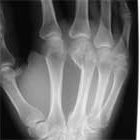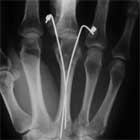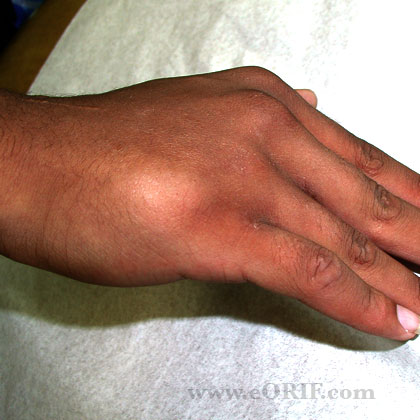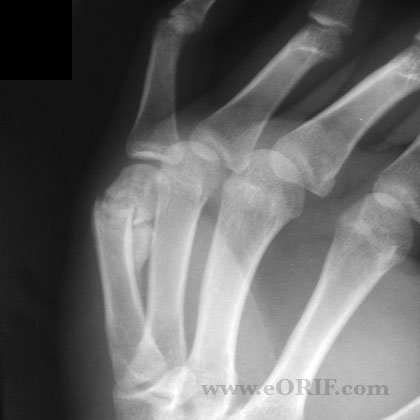|




|
synonyms: Boxer's fracture
Metacarpal Neck Fracture ICD-10
Metacarpal Neck Fracture ICD-9
- 815.04(closed),
- 815.14(open)
Metacarpal Neck Fracture Etiology / Epidemiology / Natural History
- Angulation >30 degrees, shortening >4mm or rotation 5° can lead to grip weakness, loss of endurance, cramping, clawing or an abnormal cascade..
- Unreduced apex dorsal angualtion >30° leads to a loss of the MCP joint prominence on the dorsum of the hand
- Any rotational deformity can lead to digital overlap during finger flexion
Metacarpal Neck Fracture Anatomy
Metacarpal Neck Fracture Clinical Evaluation
- Generally have obvious pain and deformity at the fracture site.
- Document neurovascular status of the finger before and after any reduction.
- Evaluate cascade, any scissoring or overlap indicates need for reduction +/- fixation
Metacarpal Neck Fracture Xray / Diagnositc Tests
- P/A and lateralviews of hand
- 30-45 degree suppinated or pronated views
Metacarpal Neck Fracture Classification / Treatment
- Small finger apex dorsal angulation <50°: cast /splint with buddy tape
- Small finger apex dorsal angluation >50°: closed reduction with ORIF vs CRPP if unstable.
- Ring Finger apex dorsal angulation <30°: cast / splint with buddy tape
- Ring finger apex dorsal angultion >30°: closed reduction with ORIF vs CRPP if unstable.
- MIddle finger apex dorsal angulation <15°: cast / splint with buddy tape
- Middle finger apex dorsal anglgutlaiton >15: closed reduction with ORIF vs CRPP if unstable.
- Index finger apex dorsal angulation < 10°: cast / splint with buddy tape
- Index finger apex dorsal angulation >10°: closed reduction with ORIF vs CRPP if unstable.
- Open fracture: consider mini-external fixation. (Freeeland AE, CORR, 1987;214:93)
- Jahss Reduction Maneuver: MCP joint flexed 70-90 degrees. Proximal fragment is compressed in a palmar direction while the metacarpal head is pushed dorsally. (Jahss SA, JBJS 1938;20:178).
- Casting technique: position of the MCP joints and the absence or presence of interphalangeal joint motion during casting has little effect on motion, grip strength, or fracture alignment (Tavassoli J, JBJS 2005;87A:2196).
Metacarpal Neck Fracture Associated Injuries / Differential Diagnosis
- Fight bite
- Fracture / dislocation of adjacent metacarpal at carpometacarpal joint
Metacarpal Neck Fracture Complications
- Cosmetic deformity
- Nonunion
- Stiffness / tendon adhesions
- Hardware failure
- Complex regional pain syndrome
- Infection
CRPP Complications=delayed union, malunion, pin tract infection, migration, wire breakage
Metacarpal Neck Fracture Follow-up Care
- Post-op: Splint in "safe" position (wrist extended 15-20 degrees, MCP joints flexed 70 degrees, PIP joint in 0-10 degrees flexion)
- 7-10 Days: remove splint. Place in removable splint with fingers buddy-taped. Encourage gentle ROM
- 6 Weeks: Check xrays. Progress with ROM exercises. Activity modifications: no heavy manual labor, no contact sports, no lifting >5 lbs.
- 3 Months: Check xrays. If union is complete return to full activities. Assess motion, consider occupational therapy if indicated.
- 6 Months: Assess motion,
- 1Yr: F/u xrays, assess outcome
Metacarpal Neck Fracture Review References
- Rockwood and Greens
- Greens Hand Surgery
- Freeland AE, Geissler WB, Weiss AP, Operative Treatment of Common Displaced and Unstable Fractures of the Hand, JBJS 2001;83A:928-945
- Freeland AE, Orbay JL. ORIF of the Tubular Bones of the Hand In: Stickland JW, Grahma TJ, editor. Hand 2nd ed. Master Techniques in orthopedic surgery. Philadeplhia: Lippincott-Raven; 2004. p 3
|




